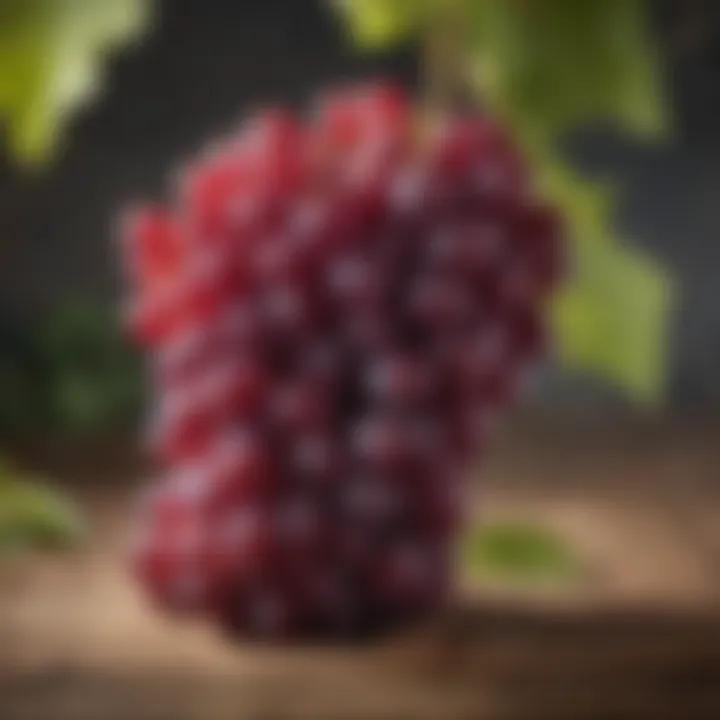Understanding Sweet Red Wines: A Complete Guide


Intro
Sweet red wines often evoke images of indulgence and culinary delight. These versatile beverages can range from light and refreshing to richly complex, creating a unique experience for wine lovers. As we explore the world of sweet red wines, it’s essential to understand their classification, production methods, and historical context. The more you know about these wines, the more you can appreciate their place in a meal or a casual evening with friends.
Historically, sweet red wines have played a significant role in various cultures, often served during celebrations or special occasions. The art of winemaking has evolved, but the fundamental principles that govern sweetness remain relevant today. By examining how these wines are crafted and what sets them apart from their dry counterparts, you’ll glean insight that enriches your culinary experiences.
Delving deeper, we will touch on the different varieties of sweet red wines, highlighting their flavor profiles and how they can pair beautifully with food. Understanding these elements not only enhances your tasting experience, but also informs your choices when selecting wine for a meal. Whether you're hosting a gathering or simply unwinding after a long day, the right sweet red can elevate any occasion.
Prologue to Sweet Red Wines
Sweet red wines offer a fascinating glimpse into the world of viniculture, combining rich flavors with a delightful sweetness that appeals to a wide audience. Exploring this topic is not just about savoring the taste but also understanding the unique journey each bottle takes from vineyard to table. For wine lovers and novices alike, the allure of sweet red wines lies in their diversity, numerous styles, and the culinary delights they can accompany.
Defining Sweetness in Wine
In the realm of wines, sweetness primarily hinges on the concept of residual sugar. This term refers to the sugar remaining after fermentation, and it can significantly influence a wine's flavor profile. When producers choose to leave some of the grape sugars unfermented, they create a sweetened product that feels rich and lush on the palate.
Many people often wonder how to quantify sweetness. The level of residual sugar in sweet red wines can vary widely—from around 10 grams per liter to well above 100 grams. A notable example is the Dessert wines, which often eclipse these figures, presenting a syrup-like texture. Understanding where a particular wine falls on this spectrum can enhance one’s choice when selecting a bottle for consumption.
The Appeal of Sweet Red Wines
The allure of sweet red wines is both simple and complex. Their intrinsic sweetness serves as a delightful counterpart to the natural acidity and tannins found in many red wines. This balance not only titillates the taste buds but also makes sweet red wines incredibly versatile in food pairings.
Local favorites like Zinfandel and Port showcase this harmony beautifully. The fruity characteristics of sweet reds stand up well against smoky barbecued meats or fresh fruit desserts, creating a symphony of flavors that’s hard to resist. Beyond just taste, sweet red wines often carry a nostalgic essence; they evoke memories of gatherings, celebrations, and special moments where a sweet touch has been a centerpiece.
"Wine is sunlight, held together by water." - Galileo Galilei
There are cultural cues too that enhance their appeal; many cultures have embraced sweet wines as part of traditional celebrations. They transition seamlessly from leading an elaborate dinner to being the perfect endcap to a casual meal. All of these factors contribute to sweet red wines standing out in the wine world, making them not just a drink, but an experience to cherish over time.
Common Terminologies
Understanding the common terminologies surrounding sweet red wines is crucial for both novices and seasoned enthusiasts. It not only enriches your appreciation but also helps in navigating the intricate world of wines with ease. The lexicon associated with sweet red wines is filled with nuances that speak to their unique characteristics and production methods, enhancing both the tasting experience and the ability to pair them with food effectively.
Types of Sweet Red Wines
Sweet red wines come in a variety of styles, each boasting distinct flavors and profiles. Here's a closer look at some popular types:
- Port Wine: Originating from Portugal, Port is fortified and often enjoyed in dessert settings, showcasing rich flavors of berry, chocolate, and spice.
- Madeira: This wine hails from the Madeira Islands and is characterized by its complex, nutty flavors and a notable sweetness, usually enjoyed as an aperitif or with dessert.
- Zinfandel: Known for its jammy and fruity profiles, Zinfandel, especially those from California, brings notes of cherry, raspberry, and even hints of spice.
- Brachetto d’Acqui: This Italian sparkling red is both sweet and aromatic, often compared to champagne but with a fruity edge, making it a delightful dessert wine.
Each of these styles not only differs in sweetness but also in terroir, grape variety, and winemaking practices, contributing to their unique flavor profiles and drinking experiences.
Understanding Residual Sugar
Residual sugar plays a pivotal role in defining the taste and classification of sweet red wines. It refers to the natural sugars left in the wine after fermentation, affecting both the wine's sweetness and mouthfeel. Here are important aspects to consider:
- Measurement of Sweetness: Wines are often categorized based on their residual sugar levels; dry wines typically contain less than 1% residual sugar, while sweet wines can have significant amounts, often exceeding 5%.
- Balancing Act: While residual sugar adds sweetness, the balance between sugar, acidity, and tannins is essential for a harmonious wine. The acidity provides structure, preventing the wine from becoming cloyingly sweet.
- Perception of Sweetness: It’s worth noting that the perception of sweetness can also be influenced by other components in the wine, such as alcohol content and body. A higher alcohol level can make a wine taste less sweet than it actually is.
"Residual sugar is the silent partner in the dance of flavors, weaving sweetness into the complex tapestry of a sweet red wine."
In sum, grasping these terminologies not only enhances your vocabulary but also deepens your understanding of how sweet red wines are crafted, enjoyed, and best paired with various cuisines. This knowledge can elevate your appreciation and give you the confidence to choose the right sweet red wines for any occasion.
Historical Context
Exploring the historical context surrounding sweet red wines provides valuable insights into their evolution over the years. Understanding this backdrop not only enriches our appreciation for the wines themselves but also enhances the experience of savoring these unique beverages. Sweet red wines have a storied past that intertwines with cultural and social developments, reflecting the tastes and preferences of different eras.
Sweet Red Wines Throughout History
Sweet red wines have traversed the ages, finding their place in various civilizations. In ancient times, cultures such as the Egyptians and Greeks cherished sweet wines, often reserved for special occasions or religious rituals. For instance, the Greeks produced a wine known as "Retsina," which was aromatic and sometimes sweet, indicating the importance of sweetness in wine appreciation. This love for sweet wines carried into the Middle Ages, where they were associated with wealth and nobility.
During this time, winemakers would often add sugar or honey to enhance sweetness, demonstrating the lengths at which people would go to satisfy their palates. By the 18th century, the popularity of dessert wines, including sweet reds, reached unprecedented heights in Europe, especially in France and Portugal. Port wine, a fortified sweet red from Portugal, became highly sought after, securing its place as a staple in many wine cellars.
Moreover, the method of producing sweet red wines saw significant advancement during these periods. For example, the use of botrytized grapes, where grapes are intentionally affected by noble rot, was refined and celebrated, allowing for the creation of wines with rich, diverse flavors. This technique was notably used in the production of Sauternes, a revered French sweet wine.
The evolution of viticulture, including better understanding and management of grape varieties, further influenced the character of sweet red wines. Over centuries, different regions began to develop their unique styles and techniques, contributing to a rich tapestry of sweet red wines enjoyed today.


Cultural Significance of Sweet Wines
Sweet red wines not only serve as beverages but are also interwoven into the fabric of many cultures around the globe. They play a pivotal role in celebrations, family gatherings, and even in culinary traditions where they complement diverse cuisines. For example, in Italy, sweet reds are often paired with rich desserts like tiramisu or served alongside artisanal cheeses, reflecting the country's deep-rooted culinary heritage.
Furthermore, in many cultures, sweet wines are viewed as a symbol of hospitality and warmth. Offering a glass of sweet wine can create an inviting atmosphere, translating to a sentiment of generosity. Historically, they have also been used in traditional healing practices, believed by some to possess restorative properties.
Interestingly, sweet red wines have maintained a presence in religious ceremonies across various faiths. They are often employed in rituals, highlighting their significance beyond mere consumption. The act of sharing a sweet wine can symbolize communion and connection among people.
In contemporary settings, the renewed interest in sweet red wines among younger consumers is noteworthy. With a focus on unique flavor experiences and new cocktail trends, sweet reds are gaining momentum in modern social contexts.
Production Process
The production process of sweet red wines is fundamental to shaping the final product's quality, character, and appeal. It reflects the care and artistry involved in winemaking and greatly affects the flavor profile, aroma, and texture of the wine. A winemaker's choices in handling grapes, fermentation, and aging all play crucial roles in determining how sweet and complex the resulting wine will be.
Harvesting Grapes for Sweet Wines
Harvesting is where it begins, and timing is key. Grapes destined for sweet red wines need to reach optimal ripeness. Usually, those grapes are allowed to hang longer on the vine, allowing them to gain additional sugars. This process is sometimes referred to as botrytis, where a type of fungus naturally dehydrates the grapes, concentrating sugars and flavors.
Most sweet wines, like Port or Zinfandel, focus on harvesting late-season grapes. Vineyard workers often check the Brix level, a measurement that tells how sweet the juice is, to ensure they're picking at the right time.
Some winemakers dry the grapes after harvest, enhancing the sweetness even further. It's not just a matter of gathering; it involves keen observation and experience.
Fermentation Techniques
Once harvested, the grapes undergo fermentation. Here, the natural sugars transform into alcohol, and this is where the art and science of winemaking truly converge. Winemakers have various methods to halt this process uniquely. For sweetness, vinification can be halted early, leaving a higher residual sugar level in the wine.
One notable technique is the use of fortification, adding distilled spirits to the wine during fermentation. This method not only raises the alcohol level but also preserves sweetness, as seen in Port wines. Another approach involves a controlled fermentation process with cool temperatures to slow down the yeast activity, ensuring unconverted sugars remain. Each choice here influences the wine's profile.
Aging and Maturation
Aging is where the magic continues. Sweet red wines often spend time in barrels or tanks, allowing them to develop deeper flavors while smoothing out any rough edges. This phase can take anywhere from a few months to several years, depending on the wine type and desired complexity.
Barrel aging can impart rich notes of vanilla, tobacco, or sweet spices, while stainless steel aging might retain the fresher, fruitier aspects of the wine. This part of the process is akin to a winemaker’s canvas, where they can draw out a wine’s potential. The interactions between the wine and the storage vessel, coupled with environmental factors, contribute to the unique character of each vintage.
Aging not only mellows the flavors but also allows the wine to evolve, making each bottle a unique experience.
The entire production process highlights the delicate balance of nature, science, and creativity. Wine lovers appreciate how each step contributes to the intricate tapestry of sweet red wines, resulting in delightful bottles to savor.
Popular Varieties of Sweet Red Wines
Sweet red wines come in many flavors and styles, each bringing its own unique characteristics to the table. These varieties not just add diversity to the wine world, but they also allow flexibility in food pairing, making them appealing to all types of wine lovers. Understanding these popular varieties can enhance your appreciation, whether you’re a casual drinker or a seasoned connoisseur.
Port Wine
Port wine, hailing from the Douro Valley in Portugal, is often a favorite among sweet red wine aficionados. This fortified wine, typically rich and opulent, is made by adding grape spirits during fermentation, which halts the process and retains the natural sweetness of the grapes.
The flavor profile of Port can range from berry-like to chocolatey, with additional notes of spices and caramel that develop over time. It's commonly enjoyed after dinner, often paired with strong cheeses like blue cheese, or maybe even chocolate desserts. The versatility in flavor makes Port a go-to choice for many.
Madeira
Madeira is another strong contender in the sweet red wine category, with an intriguing history linked to long sea voyages. Originating from the Madeira Islands off the coast of Portugal, this wine undergoes a unique heating process called estufagem, which contributes to its complex taste and remarkable longevity.
Flavors in Madeira can present a mingling of nuts, dried fruits, and sometimes even a bit of smokiness. Pairing Madeira with dishes like roasted meats or spicy barbecue can elevate the meal, making it a wonderful choice for gatherings and festive occasions.
Zinfandel
Zinfandel stands out as a quintessentially American wine, primarily produced in California. The sweet versions of Zinfandel often bear a jammy character with bursts of blackberries, cherries, and spiced undertones. There's a sense of warmth that Zinfandel brings, making it quite comfortable to drink, whether on its own or with food.
Barbecue ribs or pepperoni pizza can find a pleasing partner in Zinfandel's rich, fruity persona. It’s not just a wine; it encapsulates the spirit of casual gatherings and good times.
Brachetto d’Acqui
Brachetto d'Acqui offers a refreshing contrast with its slightly fizzy nature and lower alcohol content, making it popular among those who prefer lighter wines. This Italian sweet red wine boasts flavors of strawberries and raspberries, wrapped in delicate floral notes, providing a perfect escape on a summer afternoon.


It's often envisioned accompanying desserts, particularly anything berry related such as pavlova or a summer fruit tart. Brachetto's playful bubbles add an extra layer of fun, making it a delightful choice for women’s brunches or picnic gatherings.
Sweet red wines provide a rich tapestry of flavors that can connect food and drink in imaginative ways, enhancing not just meals but entire experiences.
In essence, exploring these popular sweet red wines enriches our understanding of flavor and pairing possibilities. Each variety not only carries its own story but also opens doors to unique culinary experiences.
Regional Specialties
When it comes to sweet red wines, the regions where they are produced have a significant impact on their character and flavor profile. Understanding these regional specialties is crucial for anyone looking to deepen their appreciation for sweet red wines. By recognizing the influence of geography, climate, and local traditions, wine lovers can better appreciate the nuances in these beverages, including tasting notes and the winemaking philosophies behind them.
Each country has its own approach to crafting sweet red wines, whereby factors such as native grape varieties and historical practices play a vital role. The value of exploring these regional specialties lies not only in the enjoyment of the wines themselves but also in the story they tell about a locality’s culture, environment, and the artisans behind the bottle.
Italian Sweet Red Wines
Italian sweet red wines are often infused with history and are beloved for their robust flavors and charming sweetness. The country is home to a wide variety of regions, each producing distinct styles of sweet red wines, thanks to differing climates and soil types.
One of the standout examples is the Moscato d’Asti, a gently sparkling wine that features bright floral and fruity notes. It's often enjoyed with desserts or light appetizers. Another notable mention is Recioto della Valpolicella, made from dried grapes, which results in a wine rich with intense flavors of cherry, chocolate, and spice. This wine exemplifies the concept of appassimento, or drying grapes, which intensifies the sugars and flavors, leading to a sweeter end product.
In the south, Aglianico grapes are transformed into sweet wines through late harvest methods, where growers intentionally delay harvesting. This allows the grapes to reach higher sugar levels, creating a luscious sweetness that still retains acidity and balance. Italian sweet red wines thus not only satisfy the palate but also connect drinkers to the rich cultural tapestry of Italy’s winemaking history.
French Approaches to Sweetness
France is synonymous with excellence in winemaking, and sweet red wines are no exception. The French have developed a diverse array of methods for producing these indulgent wines, each with place-specific nuances.
A quintessential French sweet red is Banyuls, from the Roussillon region. This fortified wine is produced using Grenache grapes and boasts a complex flavor profile with notes of figs, nuts, and chocolate. It’s a marvelous accompaniment to cheeses and desserts, showcasing the traditional technique of mutage, where fermentation is stopped early by the addition of alcohol, preserving natural sweetness.
In other parts of the country like Bordeaux, Sauternes is well-known, but it primarily features white grapes. However, certain red blends can achieve sweetness, particularly when affected by noble rot, also known as botrytis cinerea. This fungus concentrates the sugars and contributes unique flavors, creating a luxurious wine experience.
Overall, France’s approach to crafting sweet wines reflects a deep respect for tradition while allowing for innovation within the industry. By enjoying these regional specialties, wine enthusiasts gain a panoramic view of different methods and styles, enriching their overall tasting experience.
"Wine is sunlight, held together by water." - Galileo Galilei
This exploration of regional specialties in sweet red wines reveals the intricate relationship between location and flavor, providing insight into their unique appeal and enhancing the appreciation for this delectable category of wines.
Serving and Pairing
Serving and pairing sweet red wines correctly can elevate both the wine experience and the meal it accompanies, creating a harmonious balance that enhances the enjoyment for everyone at the table. In this section, we will explore why these elements are crucial and how they can add depth to your understanding and appreciation of sweet red wines.
Optimal Serving Temperatures
Getting the serving temperature right is more than just a detail; it's the foundation on which the flavors and aromas of sweet red wines unfold. Typically, sweet red wines are best served slightly chilled, around 55 to 65 degrees Fahrenheit (13 to 18 degrees Celsius). This temperature range allows the fruity sweetness to shine without being overwhelmed by too much warmth.
A warmer wine can mute the refreshing qualities that many enjoy, making the wine taste cloyingly sweet. Conversely, serving a sweet red too cold can mask its intricate flavor profile.
Some specific examples of how temperature affects perception:
- Ruby Port: Serve at about 60°F (15°C) to balance its sweetness with richness.
- Brachetto d’Acqui: This light red should be around 55°F (13°C) to preserve its fresh berry notes.
Investing in a good thermometer can go a long way. Remember, too, that once the wine is poured, it can warm up in the glass. So, consider the overall temperature situation as you decide on the perfect chill.
"A well-focused temperature can transform your sweet wine from merely pleasant to downright spectacular."
Food Pairings for Sweet Red Wines
Pairing sweet red wines with food can be a delightful adventure, but it also requires thoughtful consideration. Sweet red wines can be surprisingly versatile, complementing a range of flavor profiles when matched correctly.
- Rich Meats: Think braised lamb or duck with a sweet-spicy glaze; the fat from the meats harmonizes beautifully with the sweetness.
- Cheese: Creamy blue cheeses can form an exquisite contrast to the sweetness, while chèvre brings out more of the fruit flavors.
- Spicy Dishes: Consider sweet red wines alongside spicy barbecue or Asian dishes. The sweetness works to temper the heat.
- Desserts: Pair them with chocolate-based desserts or rich fruit tarts. Here, you'll be dancing in the sweet arena.
Each pairing can offer a new experience, turning a simple meal into a nuanced culinary journey. Remember that personal preferences matter greatly, so don’t hesitate to experiment and find what resonates most with your palate.
The Science of Taste
Understanding sweet red wines goes beyond just their history and production; it delves into the fascinating world of how our senses perceive flavor. The science of taste is crucial in our exploration, as it helps us comprehend not just why we enjoy certain wines but also how different elements interact to create a unique tasting experience. It influences everything from how wines are categorized to recommended pairings, making it evident that this subject is fundamental to fully appreciating the nuances of sweet red wines.


The study of taste involves analyzing the five basic tastes: sweet, sour, salty, bitter, and umami. This framework aids in deciphering the complex flavor profiles that sweet red wines offer. When tasting wines, engaging our sense of smell plays a significant role, as aromas often enhance or alter our perception of taste. Understanding these elements allows both novice and seasoned wine lovers to make informed choices—whether they're exploring a new bottle or pairing it with a meal.
One must also consider how environmental factors affect taste perception, including temperature, glassware, and even the setting in which the wine is enjoyed. Indulging in sweet red wines is not merely a sensory experience but a journey through the intricate interplay of flavors that our senses perceive.
"The flavor journey in sweet red wines offers layers of complexity that sometimes elude even the most practiced palate."
Taste Profiles of Sweet Red Wines
Sweet red wines generally possess a broad spectrum of taste profiles. They can range from light and fruity to rich, full-bodied selections that might surprise you with their depth. Often, these wines display a remarkable balance between sweetness and acidity, something that elevates their drinking experience.
Key Flavor Notes:
- Fruity: A prominent characteristic in many sweet red wines is the fruitiness, often featuring notes like ripe cherries, plums, or even strawberries. These flavors can make the wines taste lush and inviting.
- Spicy: Some sweet reds, particularly those made from Zinfandel grapes, include subtle hints of spice—cinnamon or black pepper, for instance—which add a level of complexity that is quite enjoyable.
- Earthy: Many sweet red wines also possess earthy undertones, which can come from specific production methods or the terroir where the grapes are grown. These notes can introduce a grounded flavor that complements the sweetness.
The interplay of these flavors results in a tasting profile that can be quite diverse. For example, a Port wine may exhibit bold chocolate or coffee notes along with its sweetness, while a Brachetto d’Acqui often comes across with floral hints that lighten the overall experience.
Perception of Sweetness
The perception of sweetness in wines isn't solely determined by residual sugar. It’s a multi-faceted experience influenced by acidity, tannin levels, and even the wine’s finishing notes. A high-acid wine can make a sweet red feel less cloying, allowing the sweetness to be more balanced and enjoyable.
Factors Influencing Sweetness:
- Residual Sugar: This is the amount of sugar left in the wine after fermentation, and it varies widely among different styles of sweet red wines. High residual sugar typically translates to a sweeter taste.
- Acidity: Wines with higher acidity can balance out sweetness, making it more palatable. For instance, an acidic sweet red like Brachetto d’Acqui can provide a refreshing contrast that accents its sweet flavor.
- Tannins: The presence of tannins in some sweet reds adds structure and complexity to the wine. This can influence the perceived sweetness by making the wine feel drier, even if it has a generous amount of residual sugar.
Understanding how these factors play together allows wine enthusiasts to dissect and appreciate the subtleties in sweet reds. This awareness enriches the tasting experience and heightens the overall enjoyment of these delightful wines.
2023 is a year brimming with new discoveries in the sweet red wine market, and knowing the science behind taste could very well change the way one approaches their next glass.
Trends in the Sweet Wine Market
The sweet wine market is a fascinating space that has seen ebbs and flows over the years. With more eyes looking towards sweeter options, understanding the prevailing trends is crucial. Not only do these patterns reflect changing consumer tastes, but they also indicate evolving production methods and innovative marketing strategies. The interest in sweet red wines has soared, making this topic an essential part of our exploration.
Growing Popularity Among Younger Consumers
In recent years, there’s been a noticeable shift. Sweet red wines are attracting the attention of younger drinkers. This is quite different than previous generations, who often shunned anything sweet, gravitating instead towards drier varieties. But what’s behind this blossoming love?
Firstly, let’s consider the experience aspect. Many younger consumers see drinking as more than just a casual activity. It’s about social gatherings and food pairings that suit their dynamic lifestyles. Sweet red wines, often seen as approachable and versatile, fit nicely into these occasions. They tend to be a crowd-pleaser, whether at a picnic or dinner party. This style allows for adventures in flavor combinations that younger generations cherish.
"Sweet wines often bring a fun twist to meals, allowing for unexpected pairings that can enchant the taste buds," says a local sommelier.
Moreover, the branding of sweet wines has taken a modern turn. Winemakers are utilizing social media platforms and influencer collaborations to woo younger audiences. They’re highlighting character and style beyond just taste. Bottle designs, labels, and vibrant storytelling resonate well with millennials and Gen Z. All of these efforts contribute to a shifting landscape, making sweet red wines not just a choice, but a lifestyle.
Innovations in Wine Production
Innovation plays a key role in the sweet wine market, influencing everything from the grapes picked to marketing strategies. As the demand for sweet red wines grows, winemakers find themselves at the forefront of new techniques that can enhance the sweetness while maintaining balance in flavor.
One noticeable shift is the focus on sustainable practices. Many producers are now aiming to minimize their ecological footprint. This involves using organic or biodynamic farming methods. Such practices not only create healthier environments but also tend to result in grapes of superior quality. Health-conscious younger consumers are drawn to such practices, allowing them to enjoy their wine with a clearer conscience.
Additionally, advanced fermentation techniques have emerged. These methods utilize controlled temperatures and special yeast strains, allowing winemakers to craft wines with precisely the desired level of sweetness while preserving intricate flavor profiles. This innovation does more than just improve quality—it elevates the entire winemaking process.
In summary, the sweet wine market is thriving amid changing consumer preferences and groundbreaking production techniques. This evolving landscape not only enriches the palate of wine enthusiasts but also opens new doors for culinary experiences and social connections.
Closure
In the world of sweet red wines, understanding the nuances and intricacies is paramount. This article underscores the significant elements that contribute to the allure of these wines. In a market that's evolving, recognizing the historical context, fermentation methods, and flavor profiles allows both enthusiasts and novices to truly appreciate what sweet red wines have to offer.
Summary of Key Insights
Through this comprehensive guide, we have explored various aspects of sweet red wines:
- Definitions and Appeal: Sweetness in wine is not merely a taste but an experience, one that resonates with many wine drinkers for its rich flavors and accessibility.
- Cultural Context: Different regions prosper in their methods and traditions, influencing the resulting sweetness and overall flavor.
- Production Processes: Attention to detail in the vineyard and cellar ensures that the aromatic profiles are preserved and enhanced.
- Serving and Pairing: Sweet red wines can shine in various gastronomic situations, providing endless possibilities for delightful pairings.
By synthesizing these insights, readers gain a more profound understanding of how sweet red wines fit into the broader spectrum of the wine world.
Future of Sweet Red Wines
Looking ahead, the sweet red wine category is likely to continue its transformation and growth. Several elements suggest an exciting future:
- Younger Demographics: As younger consumers show a growing appreciation for sweet wines, we may see innovative blends and styles tailored to their palates.
- Sustainable Practices: With an increasing emphasis on sustainability, producers are adopting eco-friendly practices, thereby enhancing wine quality and consumer trust.
- Diverse Offerings: Expect a broader spectrum of sweet red wines as adventurous winemakers experiment with unconventional varietals and fermentation methods.
Sweet red wines are poised to remain relevant, adaptable, and appealing, solidifying their place in the wine industry. As they evolve, enthusiasts and casual drinkers alike will find joy in exploring these luscious offerings.







